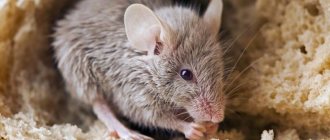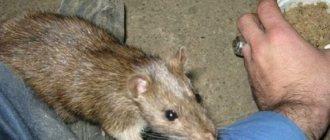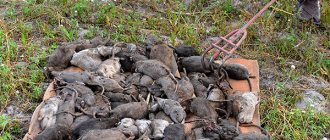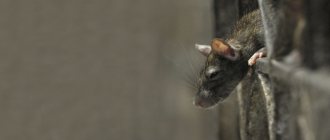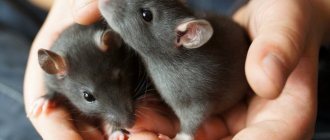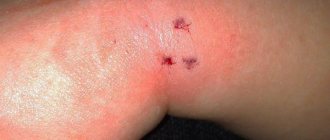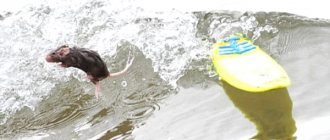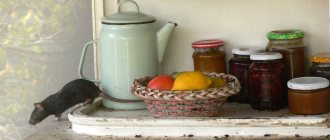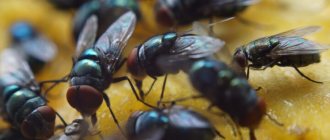Autumn is coming - and along with the cold weather, mice and rats are heading into our homes. With their arrival, not only unpleasant night noises appear in the house, interfering with sleep, but these animals pose a real danger to humans. How to get rid of unwanted neighbors?
Two of the 70 species of rats live in Russia: the gray rat (Norwegian) and the black rat. Both species belong to synanthropic species - this is the name given to animals whose life is connected with humans and their homes. Most often we see the gray rat - it is also called the barn rat, or the common rat.
What harm does a rat cause?
Most people suffer from rat phobia and experience panic at the sight of these animals with a long, bare tail. However, the fear would become even greater if people knew about the harm that rodents can cause them.
Why are rats dangerous to humans?
1. Economic harm
Rats are omnivores, so they easily find food. Where this rodent lives, your food supply is at risk. During the year, one individual eats 7-10 kg of food. Vegetables and fruits, bread, cereals, pasta - everything that comes along the way is eaten.
In addition to food, rats also damage things that are not at all edible. Furniture, paper, leather, wood, soap and even plastic - rodents do not disdain anything, living by the principle “If I don’t eat it, then at least I’ll bite it.” Often a rat causes a short circuit and a resulting fire because it chews through the insulation on the wires.
The most famous case is the accident at the Japanese nuclear power plant Fukushima-1, which occurred in 2013. The culprit of the incident was a rat that de-energized the nuclear power plant and died, by the way, at the scene of the “crime.”
In a word, the economic damage caused by rats is great not only by the standards of an individual family, but even on a national scale.
2. Diseases
However, rats destroy not only material assets. Rodents pose a great danger to human health because they are carriers of about 30 different diseases, including very dangerous ones. So that you understand the seriousness of the problem, we list some of them:
- Plague is a terrible disease that affects the lymph nodes, lungs and other internal organs, can cause sepsis and result in the death of the patient. One of the pandemics in the Middle Ages led to the death of a third of the entire population of Europe. The source of plague is often rats: their fleas, infected with plague bacteria, bite a person and thus infect him. Currently, at least 2.5 thousand cases of plague infection are recorded annually in the world.
- Tetanus is a disease with a very high mortality rate. Its development is often caused by bites of various animals, including rats.
- Q fever is a disease that is transmitted through airborne dust, food or contact, as well as through dirty hands. Sources of infection are various animals, including rats. The disease is caused by inhaling dust with their excrement or eating foods that have been bitten by infected rodents.
- Endemic (flea) typhus - transmitted from sick rodents to humans after a flea bite, as well as through food contaminated with rat excrement. Another source of infection is dust, which contains the “fecal virus” of rats, getting into the respiratory tract or onto the membranes of the eyes.
- Rabies is an incredibly dangerous fatal disease that, like tetanus, affects humans through the bites of infected animals. The source of infection can be, among other animals, rats.
- Sodoku is also transmitted to humans by a rat bite from the saliva of an infected rodent. If untreated, the mortality rate for sodoku reaches 10%.
House mouse
In autumn, “country” mice en masse look for warm and rich places.
Moreover, to do this, they are ready to cover a distance of up to 3–5 km (which is approximately equivalent to a people walking 70–90 km). Question and Answer Which animal is closest to humans?
Although in nature the house mouse prefers to eat plant seeds, in human company it becomes omnivorous - it may not disdain candles, soap or glue.
Nasty rodents can cause serious damage to the supply of vegetables and fruits in the basement, spoil cereals and pasta, damage wires and turn beds or shelves with clothes into unpleasant places. Moreover, mice carry infections that are dangerous to humans. Some of them are transmitted through their contaminants, others are carried by fleas.
These rodents are extremely fertile - they bear their first offspring at the age of only 8 weeks after birth, and then additions to the mouse family occur 5-10 times a year. Mice have not yet filled the whole world only because of their high mortality and low life expectancy (in the wild they live about one year).
The cat is out of the house - the mice are dancing? How to get rid of rodents in the countryside
More details
Why are rats difficult to get rid of?
Rats are not tigers or bears, but they are incredibly difficult to defeat. What is the reason for such amazing indestructibility?
- Fertility - one female gives from 1 to 3 litters during the year, each of which can contain up to 22 pups. Moreover, after just 3-4 months, these grown rodents themselves begin to reproduce, further increasing the population.
- Physical endurance - rats run at a speed of 10 km/h, easily jump on obstacles up to 1 m high. If necessary, these animals can stay in water for three days.
- Omnivorous - a rat cannot live more than a few days without food. However, she rarely dies of hunger, because... eats everything it comes across on its way.
- The ability to survive in various conditions - unlike most animals, rats thrive (and even reproduce) in a wide range of temperatures: from –11°C to 45°C. They are not even afraid of radiation: these rodents easily tolerate a dose of 300 roentgens/hour (for comparison: a level of 100 roentgens/hour for humans threatens the emergence of many dangerous diseases).
- Intelligence - the rat, according to some scientists, has abstract thinking and is considered one of the smartest animals. She is able to recognize poisons and warn her relatives of danger. If the rat dies immediately after eating the bait, other rodents will not even touch the deadly treat.
Rodenticides
What is the best way to poison pests? Rodenticides will help get rid of pests quickly. Poisonous specialized mixtures can be of organic or synthetic origin, and they have an odor that attracts animals. According to the method of influence there are two types:
- a) Fast
. Poisonous repellents for rats and mice, helping to quickly clean up the house. Once in the body, they cause actively developing pathologies, leading to death within 24 hours.
b) Slow (anticoagulants).
They kill slowly, over 3-15 days, even a highly concentrated single dose rarely results in the death of the creature. The active components of the drugs cause blood pathologies and animals slowly die.
When choosing a rodenticide, pay attention to mummifying compounds. After the death of the animal, the body will not decompose, emitting a stench. Over time, it will gradually turn into a mummy.
Important! Before using poisonous drugs, carefully read the instructions, follow safety precautions, and use personal protective equipment.
How to get rid of rats in the house
There are many chemicals that are designed to control rodents. However, the problem is that rats adapt to poisons very quickly and they cease to act on rodents. For this reason, scientists are constantly inventing new substances that can destroy these dangerous animals.
At the moment, some of the most effective are drugs based on anticoagulants. These substances prevent the formation of platelets in the body of rats and thus reduce blood clotting. A few days after eating the bait, the rats experience internal bleeding, which causes the death of the rodent. Due to the fact that the rat does not die immediately, the bait does not cause wariness in the rodents - the whole flock will try it without fear.
has created a whole line of Ratobor drugs, which contain the most modern active ingredients currently available - second-generation anticoagulants bromadiolone and brodifactum. Unlike their predecessors - first generation anticoagulants, they are effective after a single dose and cause the death of rats faster - on the 5-8th day.
Advantages of Ratobor baits
Rats are very sensitive to toxic substances, so they will not eat anything that makes them wary. However, in Ratobor baits the concentration of poison is so low that rats practically do not feel it, calmly eat it and do not signal their relatives about the danger.
To make the poison even more effective, some of the baits contain grain, flour and vegetable oil, which have a taste and smell that is attractive to rats.
To prevent the bait from attracting pets, it contains bitrex - a bitter substance that your four-legged pets do not like.
In addition, Ratobor baits not only effectively destroy rats and mice, but also have a mummifying effect: after death, the rats do not emit a smell. However, it usually doesn’t come to this: most rodents leave the room before they die, because after the action of the poison, they experience severe suffocation and strive to quickly get into fresh air.
Where did the idea of mice's love for cheese come from?
Back in the 1st century AD, the Roman philosopher Lucius Annaeus Seneca mentioned in one of his works:
“Mouse is a word. Let the Mouse eat the cheese, so the word eats the cheese... Without a doubt, I have to be careful, otherwise one day I will catch the words in my mousetrap, or, if I am careless, the book may swallow my cheese.”
From this it follows that the connection between mice and cheese dates back to long before our era. At the moment, there are two main theories about the origin of this myth.
Features of cheese storage
Cheese: easy prey for pests.
One of the most common versions of why people decided that mice are crazy about cheese is the way this product is stored. In ancient times, grains, salted meats and cheese were stored in the same room, as they were considered essential products.
People packed salted meat and grain tightly and protected it from possible attacks by rodents, but cheese needed good ventilation and therefore became easy prey for pests.
Ancient mythology
Domestic mouse and cheese.
The second version was put forward by Professor David Holmes. The scientist suggested that this misconception could be based on one of the ancient myths or legends, because mice were often mentioned in ancient mythology.
In particular, the ancient Greek god Apollo was called “Apollo Smyntheus”, which literally translates as “Apollo the Mouse”, and under the altar of this god people kept white mice. At the same time, the son of Apollo, Aristaeus, according to legend, taught people how to make cheese, passing on to them the knowledge received from the Libyan nymphs.
Comparing these facts, we can assume that the connection between mice and cheese originated from ancient Greek mythology.
Ratobor bait options
Ratobor baits are presented in several forms:
- dough briquette – made in the form of compressed tiles;
- grain bait - made in two versions: in the first - packaged in bags, and in the second - directly in containers;
- gel concentrate – a concentrated preparation that needs to be mixed with a self-prepared edible base (bread, grain, mixed feed, etc.), then add vegetable oil and flour and spread in places where rodents move;
- wax tablets are an ideal option for damp rooms (cellar, garage, garden, etc.), where conventional preparations get wet very quickly and lose their effectiveness. The tablets are treated with wax, so they are not afraid of dampness: they remain effective even in such conditions;
- granules are another option for wet areas. Solid granules do not break and are resistant to soaking.
Cats
Another one that eats mice is the lynx. In the absence of larger prey, the predator is able to satisfy its appetite with several rodents.
The body length of the animal, which belongs to the cat family, is about a meter. The lynx is distinguished from a cat by its graceful ears with tufts and hard rumps framing its muzzle. A distinctive feature of the predator is also its short, stubby tail.
How to use Ratobor baits correctly
All preparations are laid out along baseboards, near pipes, near rat and mouse holes - in a word, in those places where rodents most often appear. You need to lay out the bait on some kind of substrate. This could be a sheet of cardboard, tin or plastic lids, small jars or trays with low walls. The distance between the “treats” depends on the room: in a free room, baits can be placed at a distance of 4 m from each other, in a crowded room there should be no more than 2 m between them. The more baits you place, the higher the likelihood that rats will find and try them.
The danger posed by rats is very great, so you need to fight them in the most merciless and effective ways.
The best pest control products are sold in our online store
Fighting mice and rats in the house will bring a minimum of hassle if you use repellers and rodenticides from our online store.
The site's catalog contains the best products that have been tested and really work. Each unit of production is certified, instructions are attached to it, and a guarantee is given. You no longer need to visit hundreds of stores in search of security devices. Buy insect and animal repellents from us, choose a lot of other products: exterminators, insecticides, auto diagnostic devices. People often come to us with the request: “Help! Tell me a good remedy for insects, fleas, bedbugs.” Call the toll free number. Our consultants will be happy to tell you about the products and help you make the right choice. We deliver orders throughout Moscow, Moscow Region, and other regions of Russia. When ordering from 4000 rub. free delivery.
Ferrets
Ferrets and foxes eat mice
Stocky with a flexible, elongated body, the animal has disproportionately muscular short legs, which allows them to move by jumping and swim perfectly. Long, strong claws on the fingers make it possible to dig deep holes and deftly climb trees. They are used to catch ferrets and mice.
The ferret's body length is about 50 cm, the animal has a flexible neck, an oval head and a slightly blunt muzzle towards the nose. The fluffy tail is a source of pride for the animal (in adults it can reach up to 20 cm). Near it there are special glands that secrete a specific secretion with a pungent odor.
The thick fur covering the animal's body is lighter at the base and darker in color at the tip. It is especially beautiful after the autumn molt, becoming more silky and shiny. The animal's color range can vary from light sand to almost black tones.
Weasels and martens
In addition to cats, martens and weasels eat mice. In addition, they do it much faster and more efficiently, because mice are the main diet of animals. In the housing where the weasel hunted, the rodents disappear within 5-7 days.
Weasels are very active and nimble animals that, despite their cute appearance and small size, keep even larger animals at bay. The body length of predators is 20-22 cm. The long narrow body of a predator makes it possible to easily penetrate a rodent burrow and eat a vole or wood mouse hiding there.
The animal has an attractive white (in winter) and brown-brown (summer) coat, a slightly narrowed head, small ears and a muzzle. Distinctive features of the weasel are large dark eyes and a long tail, under which there are glands that secrete a specific pungent odor. It is thanks to this aroma that the animal scares away other predators.
The marten is no worse at hunting mice. The representative of the large family of mustelids has thick soft fur, colored in dark brown or brown-chestnut tones. The length of the slender, slightly elongated body does not exceed 55-58 cm. The distinctive characteristics of the agile animal are a yellow round throat spot and a fluffy tail, the length of which can be almost half the length of the marten’s body (16-28 cm). The predator has very short five-fingered paws with claws.


